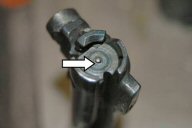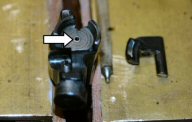Fixing
the Ruger® Mini 14/30 Bolt to Shoot Imported Ammunition
by Roy Seifert
Click here to purchase a
CD with this and all Kitchen Table Gunsmith Articles.
Disclaimer:
This article is for entertainment only and is not to
be used in lieu of a qualified gunsmith.
Please defer all firearms work to a qualified
gunsmith. Any loads
mentioned in this article are my loads for my guns and have
been carefully worked up using established guidelines and
special tools. The
author assumes no responsibility or liability for use of
these loads, or use or misuse of this article.
Please note that I am not a professional gunsmith,
just a shooting enthusiast and hobbyist, as well as a
tinkerer. This
article explains work that I performed to my guns without
the assistance of a qualified gunsmith.
Some procedures described in this article require
special tools and cannot/should not be performed without
them.
Warning:
Disassembling and tinkering with your firearm may
void the warranty. I
claim no responsibility for use or misuse of this article.
Again, this article is for entertainment purposes
only!
Tools
and firearms are the trademark/service mark or registered trademark
of their respective manufacturers.
Many years ago I purchased a
Ruger® Mini-14 in .223 Remington caliber.
The manual that came with it stated point-blank that
I should not use imported ammunition with this rifle.
I soon found out why.
After firing only 30 rounds
of Russian .223 ammunition, the rifle would no longer fire.
Upon examination, I found the firing pin was jammed.
I disassembled the bolt and found it filled with
small, round, brass disks! I
removed the disks, fired another 30 rounds, and again, the
firing pin was jammed because the bolt was filled with those
brass disks. I
recovered some spent shells and discovered each primer had a
neat, round hole in the center of the primer that
corresponded with the brass disks I found inside the bolt.
 I
carefully examined the bolt face and found a sharp burr around
the firing pin hole (probably raised during the machining
process when Ruger® drilled the hole).
I also discovered that the firing pin was protruding
too far in front of the bolt face.
The long firing pin would create a too-deep indentation
in the primer. During
recoil the case head was pressed against the bolt face, where
the burr would cut out the center.
These two conditions would cause the center of the
primer to be cut out into a round disk, and the blowback would
cause that disk to be blown into the bolt body through the
firing-pin hole. Enough
disks blown into the bolt body would jam the firing pin. I
carefully examined the bolt face and found a sharp burr around
the firing pin hole (probably raised during the machining
process when Ruger® drilled the hole).
I also discovered that the firing pin was protruding
too far in front of the bolt face.
The long firing pin would create a too-deep indentation
in the primer. During
recoil the case head was pressed against the bolt face, where
the burr would cut out the center.
These two conditions would cause the center of the
primer to be cut out into a round disk, and the blowback would
cause that disk to be blown into the bolt body through the
firing-pin hole. Enough
disks blown into the bolt body would jam the firing pin.
 The fix was easy.
I removed the extractor and firing pin. Then I used a
narrow 400-grit stone to
remove the burr around the firing pin hole.
Note in the photo the white ring around the firing pin
hole. This indicates I removed the burr. I then shortened the firing pin by 0.010”.
I did this by rubbing the end of the firing pin on a
smooth stone being careful to maintain a round end.
Now I could fire my Mini-14 all day using imported
ammunition with no failures or jamming. The fix was easy.
I removed the extractor and firing pin. Then I used a
narrow 400-grit stone to
remove the burr around the firing pin hole.
Note in the photo the white ring around the firing pin
hole. This indicates I removed the burr. I then shortened the firing pin by 0.010”.
I did this by rubbing the end of the firing pin on a
smooth stone being careful to maintain a round end.
Now I could fire my Mini-14 all day using imported
ammunition with no failures or jamming.
Ruger® has since rewritten
their manuals and removed this restriction.
However, I recently purchased a Mini-30 and the bolt still
had a burr, which I polished smooth to avoid any problems
with imported ammunition.
|